Jenway 7200 Instruction Manual

Spectrophotometer
Model 7200
Operating Manual
720 005 REV A 07/13
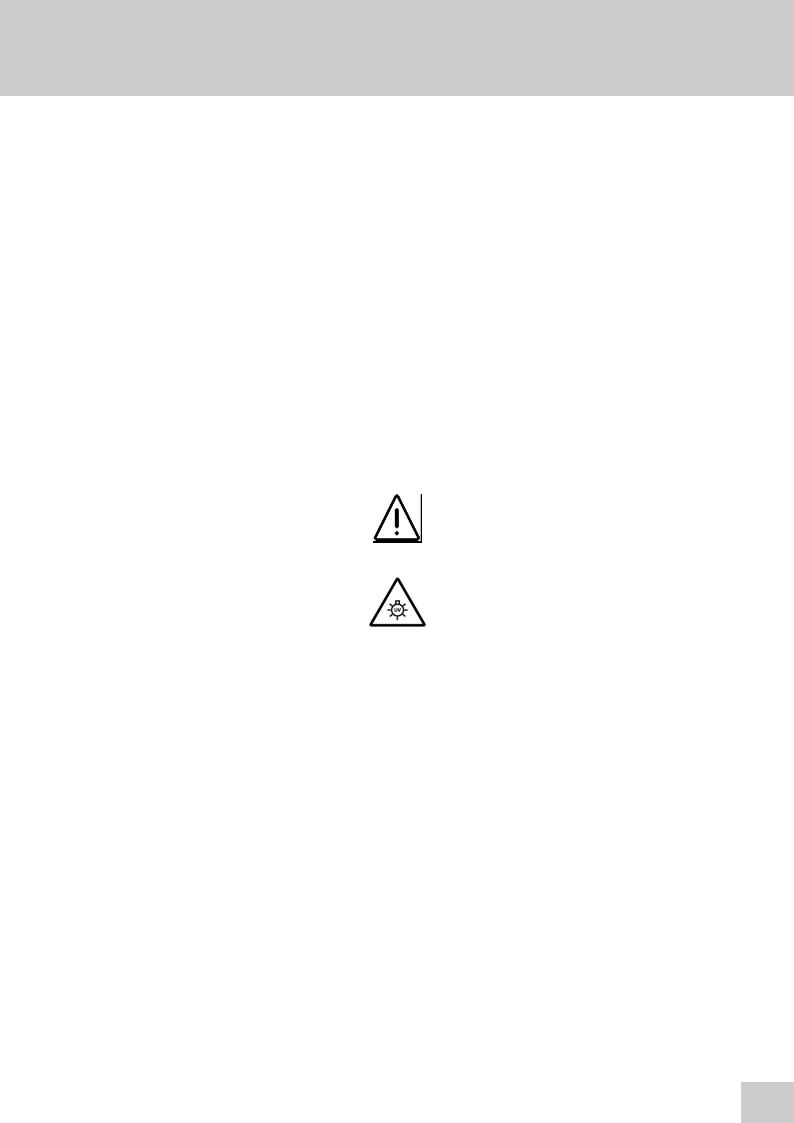
Safety
Please read this information carefully prior to installing or using this equipment.
1.The unit described in this manual is designed to be operated only by trained personnel. Any adjustments, maintenance and repair must be carried out as defined in this manual, by a person qualified to be aware of the hazards involved.
2.It is essential that both operating and service personnel employ a safe system of work, in addition to the detailed instructions specified in this manual.
3.Other than for those items defined in the maintenance procedures herein there are no user serviceable items in this instrument. Removal of covers and attempted adjustment or service
by unqualified personnel will invalidate the warranty and may incur additional charges for repair.
4.References should always be made to the Health and Safety data supplied with any chemicals used. Generally accepted laboratory procedures for safe handling of chemicals should be employed. Do not use hazardous or flammable substances in the instrument.
5.If it is suspected that safety protection has been impaired in any way, the unit must be made inoperative and secured against any intended operation. The fault condition should immediately be reported to the appropriate servicing authority.
6.The warning symbol alerts the user to important information about using the instrument. Read and follow the associated instructions carefully.
7.This instrument uses a UV light source. Do not look directly at the light source.
8.WARNING: If the equipment is not used in the manner specified, the protection provided by the equipment may be impaired.
9.Do not replace the detachable mains leads with inadequately rated leads.
Merci de lire attentivement ces informations avant d’installer ou d’utiliser cet appareil.
1.L’appareil décrit dans ce manuel est conçu pour être utilisé uniquement par des personnes formées. Tout réglage, maintenance ou réparation doit être effectué comme décrit dans ce manuel, par une personne qualifiée consciente des risques encourus.
2.Il est essentiel que les personnes utilisant et intervenant sur cet appareil respectent les règles de sécurité de travail, en plus des instructions détaillées précisées dans ce manuel.
3.En-dehors des éléments décrits dans les procédures de maintenance ci-incluses, cet appareil ne contient aucun élément réparable par l’utilisateur. L’enlèvement des capots et les tentatives
de réglage ou de réparation par des personnes non qualifiées invalide toute garantie et entraîne un risque de frais de réparation supplémentaires.
4.Toujours se référer aux fiches techniques de santé et de sécurité accompagnant tout produit chimique utilisé. Respecter les procédures de laboratoire généralement acceptées pour la manipulation en toute sécurité des produits chimiques. Ne pas utiliser de substances dangereuses ou inflammables sur l’appareil.
3

5.Si l’utilisateur suspecte qu’un problème quelconque puisse mettre en cause la sécurité, l’appareil doit être rendu inopérant en empêchant son utilisation. Communiquer la défaillance constatée au service de maintenance compétent.
6.Le symbole d’alerte signale à l’utilisateur les informations importantes concernant l’utilisation de l’appareil. Lire et suivre les instructions fournies avec la plus grande attention.
7.Cet appareil utilise une source lumineuse UV. Ne pas regarder directement vers la source.
8.ATTENTION. Si l’appareil n’est pas utilisé de manière adéquate, la protection de l’appareil pourrait être impactée.
9.Ne pas remplacer le cordon d’alimentation fourni par un cordon d’alimentation de dimension électrique non adapté.
Bitte lesen Sie diese Hinweise vor Installation oder Gebrauch dieser Ausrüstung sorgfältig durch.
1.Das in diesem Handbuch beschriebene Gerät darf nur von geschultem Personal bedient werden. Alle Anpassungen, Wartungsarbeiten und Reparaturen müssen entsprechend der Vorgaben in diesem Handbuch und von einer kompetenten Person, die mit den damit verbundenen Gefahren vertraut ist, durchgeführt werden.
2.Es ist wichtig, dass sowohl das Bedienungsals auch das Service-Personal zusätzlich zu den detaillierten Anweisungen in diesem Handbuch ein sicheres Arbeitssystem einsetzen.
3.Mit Ausnahme der Teile, deren Wartungsverfahren in diesem Handbuch beschrieben sind, enthält dieses Gerät keine weiteren Teile, die vom Benutzer gewartet werden können. Das Entfernen von Abdeckungen und Versuche von hierfür unqualifiziertem Personal, Anpassungen oder Wartungsarbeiten durchzuführen, haben zur Folge, dass die Garantie verfällt und können zusätzliche Reparaturkosten auslösen.
4.Es ist jederzeit auf die sicherheitsrelevanten Daten sämtlicher verwendeter Chemikalien Bezug zu nehmen. Allgemein anerkannte Labormethoden zum sicheren Umgang mit Chemikalien sollten eingesetzt werden. Verwenden Sie keine gefährlichen oder entzündlichen Stoffe in Verbindung mit dem Gerät.
5.Besteht der Verdacht, dass die Sicherheitsvorrichtungen in irgendeiner Weise beschädigt wurden, muss das Gerät außer Betrieb genommen und gegen weiteren Gebrauch gesichert werden. Die Störung sollte der zuständigen Serviceeinrichtung unverzüglich gemeldet werden.
6.Das Warnsymbol weist auf wichtige Informationen zur Verwendung des Geräts hin. Lesen und befolgen Sie die dazugehörigen Anweisungen sorgfältig.
7.Dieses Instrument greift auf eine UV-Lichtquelle zurück. Nicht direkt in die Lichtquelle schauen.
4
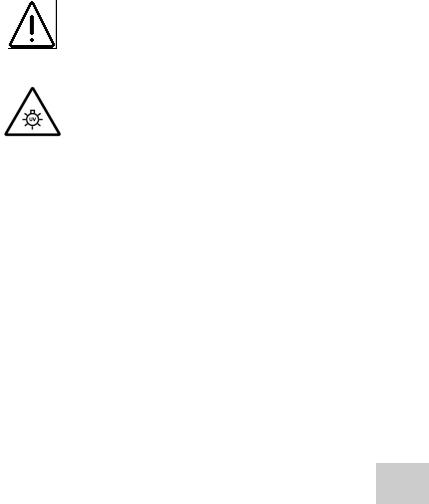
8.ACHTUNG: Wenn das Gerät nicht in der vorgegebenen Weise eingesetzt wird, können die Schutzfunktionen des Gerätes beeinträchtigt werden.
9.Abnehmbares Anschlusskabel nicht durch unangemessen bewertete Kabel austauschen.
Leggere attentamente queste istruzioni prima di installare o utilizzare il dispositivo.
1.L’unità descritta nel presente manuale è stata realizzata per essere utilizzata solo da personale che ha ricevuto l’apposita formazione. Qualsiasi operazione di regolazione, manutenzione e riparazione deve essere effettuata sulla base di quanto indicato nel presente manuale da personale qualificato consapevole dei rischi connessi.
2.È fondamentale che il personale operativo e il personale addetto alla manutenzione utilizzino un sistema di lavoro sicuro, oltre a seguire le istruzioni specificate nel presente manuale.
3.Oltre a quelli indicati nelle procedure di manutenzione, all’interno di questo dispositivo non sono presenti altri elementi sui quali è possibile effettuare interventi. La rimozione delle protezioni e qualsiasi tentativo di regolazione o di manutenzione posto in essere da personale non qualificato invaliderà la garanzia. In questi casi, sarà necessario pagare un importo per le riparazioni effettuate.
4.È sempre necessario fare riferimento ai dati sulla salute e sulla sicurezza forniti con le sostanze chimiche utilizzate. Adottare le procedure di laboratorio generalmente accettate per la gestione delle sostanze chimiche. Non utilizzare sostanze pericolose o infiammabili sullo strumento.
5.Nel caso in cui si sospetti che la salute possa essere pregiudicata in qualsiasi modo, disattivare l’unità per renderla inutilizzabile. Qualsiasi condizione di errore deve essere immediatamente segnalata al responsabile per la manutenzione.
6.Il simbolo di avvertenza informa l’utente sulle informazioni importanti in merito all’uso dello strumento. Leggere e seguire le istruzioni corrispondenti con cura.
7.Questo strumento utilizza una sorgente di luce UV. Non guardare direttamente la sorgente di luce.
8.AVVERTENZA: qualora il dispositivo non venga utilizzato nel modo descritto, la protezione fornita dal dispositivo stesso potrebbe risultare compromessa.
9.Non sostituire i cavi di alimentazione di rete scollegabili con cavi inadeguati.
Lea esta información atentamente antes de instalar o utilizar este equipo.
1.La unidad descrita en este manual está diseñada para que solamente la utilice personal con formación. Cualquier operación de ajuste, mantenimiento y reparación debe llevarse a cabo del modo indicado en este manual y debe realizarla una persona cualificada que sea consciente de los peligros que implica.
2.Es fundamental que tanto los operarios como el personal de servicio utilicen un sistema de trabajo seguro, así como las instrucciones detalladas que se especifican en este manual.
5
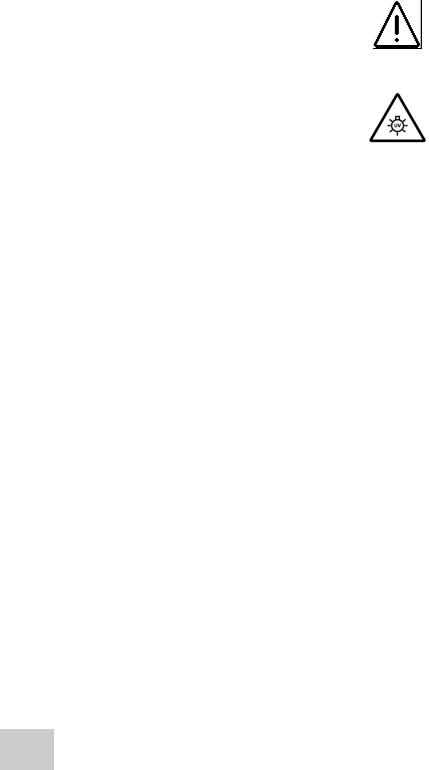
3.Cualquier elemento que no se encuentre entre los definidos en los procedimientos de mantenimiento aquí descritos no podrá utilizarse en este instrumento. La extracción de las tapas y los intentos de ajuste o reparación por parte de personal no cualificado invalidarán la garantía y pueden incurrir en cargos adicionales por reparación.
4.Siempre deberían consultarse los datos sobre Salud y Seguridad que se suministran con cualquier producto químico que se utilice. Es necesario llevar a cabo los procedimientos de laboratorio de aceptación generalizada para la manipulación segura de productos químicos. No utilice sustancias peligrosas o inflamables en el instrumento.
5.Si existe la sospecha de que las medidas protectoras de seguridad han quedado dañadas en cualquier modo, la unidad debe inutilizarse y protegerse contra toda operación que se intente llevar a cabo. El estado de fallo debe comunicarse inmediatamente a la autoridad de servicio de mantenimiento y reparación pertinente.
6.El símbolo de advertencia avisa al usuario de información importante relacionada con el uso del instrumento. Lea atentamente y siga las instrucciones correspondientes.
7.Este instrumento utiliza una fuente de luz UV. No mire directamente a la fuente de luz.
8.ADVERTENCIA: Si el equipo no se utiliza de la manera especificada, la protección que ofrece el aparato puede verse afectada.
9.No sustituya el cable de alimentación eléctrica con cables de voltaje inadecuado.
6

Contents
|
|
Page |
Safety |
|
3 |
Section 1 - Introduction |
11 |
|
1.1 |
Instrument description |
11 |
1.2 |
Instrument specification |
12 |
Section 2 - Installation |
13 |
|
2.1 |
Unpacking |
13 |
2.2 |
Installation |
13 |
2.3 |
Rear panel |
14 |
2.4 |
Front access panel |
14 |
2.5 |
Lamp access panel |
15 |
2.6 |
Display |
15 |
Section 3 - Theory and practice of spectroscopy measurements |
16 |
|
3.1 |
Theory of spectroscopy measurement |
16 |
3.2 |
Spectroscopy measurement |
17 |
3.3 |
Good practice guidelines |
17 |
Section 4 - Instrument setup |
19 |
|
4.1 |
Navigating and screen setup |
19 |
4.2 |
Instrument settings screen |
19 |
4.3 |
Printing and saving |
20 |
4.4 |
Heated cell accessory control |
21 |
4.5 |
Date and time |
22 |
4.6 |
Language |
23 |
4.7 |
Software update |
23 |
Section 5 - Single wavelength |
25 |
|
5.1 |
Simple (abs/%t) measurement mode |
26 |
5.1.1 |
Method set up |
26 |
5.1.2 |
Selecting a wavelength |
26 |
5.1.3 |
Measurement name |
27 |
5.1.4 |
Blank calibration and sample measurement |
27 |
5.2 |
Optical density measurement mode |
28 |
5.2.1 |
Method setup |
28 |
5.2.2 |
Selecting a wavelength |
29 |
5.2.3 |
Measurement name |
29 |
5.2.4 |
Entering a factor |
29 |
7

5.2.5 |
Entering concentration units |
30 |
5.2.6 |
Blank calibration and sample measurement |
30 |
5.3 |
Use a factor measurement mode |
31 |
5.3.1 |
Method setup |
32 |
5.3.2 |
Selecting a wavelength |
32 |
5.3.3 |
Measurement name |
32 |
5.3.4 |
Entering a factor |
33 |
5.3.5 |
Units of measure |
33 |
5.3.6 |
Blank calibration and sample measurement |
33 |
5.4 |
Use standard(s) measurement mode |
35 |
5.4.1 |
Method setup |
35 |
5.4.2 |
Selecting a wavelength |
36 |
5.4.3 |
Measurement name |
36 |
5.4.4 |
Entering concentration units |
36 |
5.4.5 |
Selecting the number of standards and replicates |
37 |
5.4.6 |
Measuring standards |
37 |
5.4.7 |
Load standard curve |
39 |
5.5 |
Blank calibration and sample measurement |
40 |
Section 6 - Spectrum |
42 |
|
6.1 |
Method setup |
42 |
6.1.1 |
Measurement name |
42 |
6.1.2 |
Selecting measurement mode |
43 |
6.1.3 |
Setting start and end wavelengths |
43 |
6.2 |
Blank calibration and sample measurement |
44 |
6.3 |
Data analysis |
45 |
6.3.1 |
Spectrum zoom |
45 |
6.3.2 |
Spectral points analysis |
46 |
Section 7 - Kinetics |
47 |
|
7.1 |
Method setup |
47 |
7.1.1 |
Measurement name |
47 |
7.1.2 |
Selecting number of wavelengths |
48 |
7.1.3 |
Selecting measurement mode |
48 |
7.1.4 |
Run time |
48 |
7.1.5 |
Lag time (seconds) |
48 |
7.1.6 |
Selecting concentration units |
49 |
7.1.7 |
Selecting a wavelength and factor |
49 |
7.2 |
Blank calibration and sample measurement |
50 |
7.3 |
Post measurement analysis |
51 |
8

Section 8 - Glossary of icons |
52 |
|
SECTION 9 - Accessories and spare parts |
54 |
|
9.1 |
Optional accessories |
54 |
9.2 |
Connecting the accessories |
54 |
9.2.1 |
External printer |
54 |
9.2.2 |
Passive accessories |
54 |
9.2.3 |
Active accessories |
55 |
9.3 |
Spares |
56 |
Section 10 - Maintenance and service |
57 |
|
10.1 |
Routine maintenance and cleaning |
57 |
10.2 |
Lamp replacement |
57 |
10.2.1 |
Halogen lamp module replacement |
57 |
10.3 |
Firmware update procedure |
59 |
10.4 |
Service |
59 |
Section 11 - Troubleshooting |
60 |
|
11.1 |
Error codes |
60 |
11.2 |
Troubleshooting guide |
64 |
11.3 |
Technical support |
64 |
Section 12 - Declaration of conformity |
65 |
|
9

10

SECTION 1 - Introduction
1.1INSTRUMENT DESCRIPTION
Model 7200 is a visible diode array spectrophotometer which is suited to a wide range of applications in education, quality control, environmental and clinical analysis. This spectrophotometer covers a wavelength range from 335nm to 800nm, with measurement modes for photometrics, concentration, spectrum scanning, quantitation and kinetics. This spectrophotometer has a touchscreen user interface for improved navigation.
11

1.2INSTRUMENT SPECIFICATION
|
7200 |
Wavelength |
|
Range |
335 to 800nm |
Accuracy |
± 2nm |
Repeatability |
± 2nm |
Spectral bandwidth |
7nm |
Photometrics |
|
Absorbance |
-0.300 to 2.500A |
Accuracy |
+/- 0.01A at 1.0A and 546nm |
Stability (A) |
+/- 0.005A/h at 0.04A and 546nm |
Noise |
+/- 0.002A at 0.04A and +/- 0.02A at 2.0A and 546nm |
Stray Light at 340nm, %T |
<1%T according to ANSI/ASTM E387-72 |
Concentration |
|
Range |
+/- 2500 |
Calibration |
Blank with a single standard or factor |
Factor |
+/- 1000 |
Standard |
+/- 1000 |
Optical Density |
|
Factor |
+/- 1000 |
Quantitation |
|
Range |
+/- 2500 |
Calibration |
Blank with up to 6 standards |
Curve fit algorithms |
Linear and linear through zero |
Kinetics |
|
Measurement Time |
15 to 9999 seconds |
Number of wavelengths |
3 |
Calibration |
Blank with a factor |
Display |
Graphical and concentration |
Analysis |
Concentration |
Spectrum |
|
Range |
335 to 800nm |
Analysis |
Absorbance or % transmittance and up to 50 spectral |
|
analysis points |
Other |
|
Beam height |
15mm |
Light source |
Tungsten Halogen lamp |
Results memory |
Limited by attached USB memory stick |
Outputs |
USB x 2 |
Supply voltage/frequency |
100 – 240VAC at 50 to 60Hz |
Power supply |
12V DC, 3.8A |
Size (w x d x h) |
212 x 422 x 120mm |
Weight |
2.8kg |
Warranty |
2 years on the instrument, 1 year on the lamp |
12

SECTION 2 - Installation
2.1UNPACKING
Remove the 7200 from the packaging and ensure the following items are included:
1.Model 7200 spectrophotometer (720 001)
2.12V 3.8A power supply unit (M7980)
3.Mains Power leads UK plug (M7817UK), EU (M7817X6) and US (M7817X1)
4.Instruction manual (720 005)
5.Jenway Foreign Manual CD (JENMANCD)
2.2INSTALLATION
Model 7200 is supplied ready to use.
The unit should be placed on a clean flat surface which is free from drafts and vibrations. Do not position the equipment so that it is difficult to access the power switch or disconnect the power supply unit from the mains supply.
The unit should only be used in an environment with a temperature range of 5 to 40°C and maximum relative humidity 0 to 80% for temperatures up to 31°C, decreasing linearly to 50% at 40°C. When the instrument is used for the first time or moved to a different environmental temperature, it is important to allow the instrument to equalise to the ambient temperature. Therefore allow the unit to stand for 2 hours before switching it on.
The supplied power supply unit is designed for operation on 100vAC to 240vAC input at 50 to 60Hz. Select the power lead and attach to the power supply unit. Connect the power supply unit to the power inlet socket on the rear panel of the instrument and connect to the mains socket. Ensure that the sample chamber is empty before turning the power on at the mains and switching the instrument on using the power switch on the rear of the instrument.
The instrument will perform several power-on tests and lamp calibration before displaying the main screen.
WARNING: Leaving cuvettes in the sample holder during power up will result in failure of the power on tests.
13
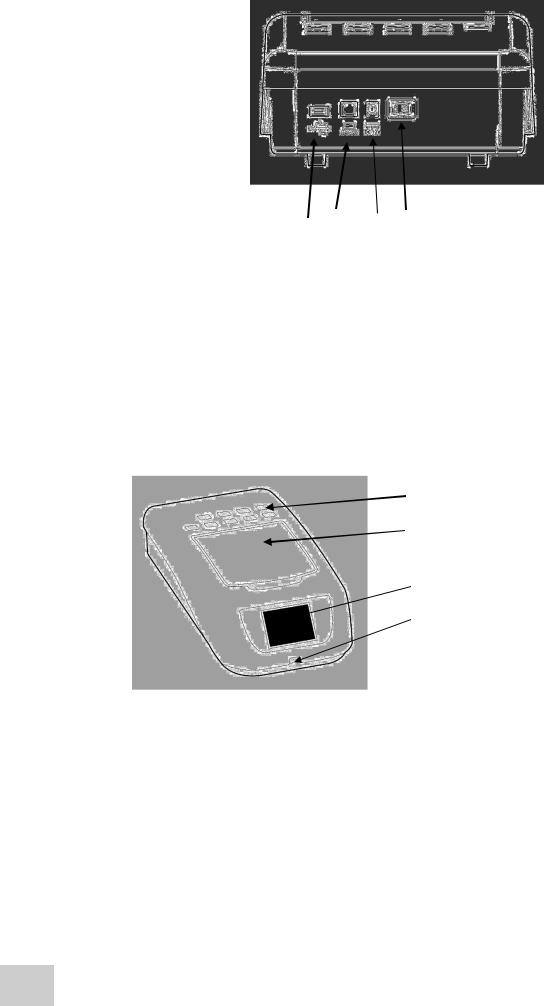
2.3REAR PANEL
The image below shows the rear panel on the instrument:
1 2 3 4
Fig. 2.3.1 – Rear Panel
1.USB port Allows connection to a USB printer
2.PC connector Allows connection to a PC
3.Power in socket Connection socket for power supply unit
4.Rocker Switch Allows the unit to be powered on or off
2.4FRONT PANEL
The image below shows the front panel of the instrument:
1. Cuvette holders (10 x 10mm) - For cuvette storage
2. Instrument lid - Provides access to sample chamber
3. Touchscreen Display - User interface
4. USB memory stick slot - Accepts USB stick
Fig. 2.4.1 – Front Panel
14
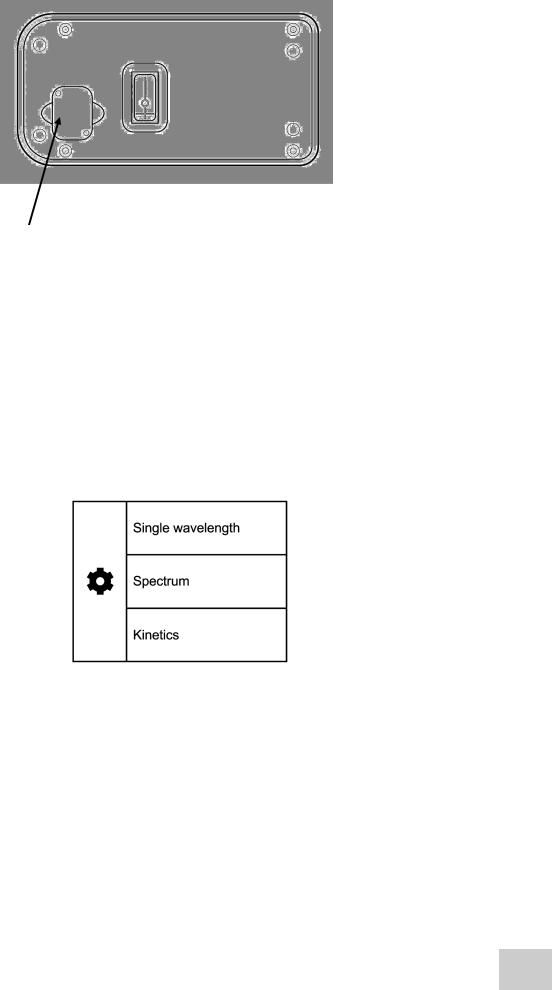
2.5LAMP ACCESS PANEL
The image below shows the lamp access panel on the underside of the instrument:
Fig. 2.5.1 – Lamp Access Panel
1
1. Lamp Access Panel Allows access to lamp when replacement is necessary
 WARNING!Refertotosection1010.2.2forforinstructionsononhowhowtotoremoveandandreplacethethelamplamp. .
WARNING!Refertotosection1010.2.2forforinstructionsononhowhowtotoremoveandandreplacethethelamplamp. .
2.6DISPLAY
The instrument has a touchscreen display which enables easy setup and navigation of the instrument.
Fig. 2.6.1 – Main Screen
•Settings
•Single Wavelength Measurement Modes
•Spectrum Measurement Mode
•Kinetics Measurement Mode
15
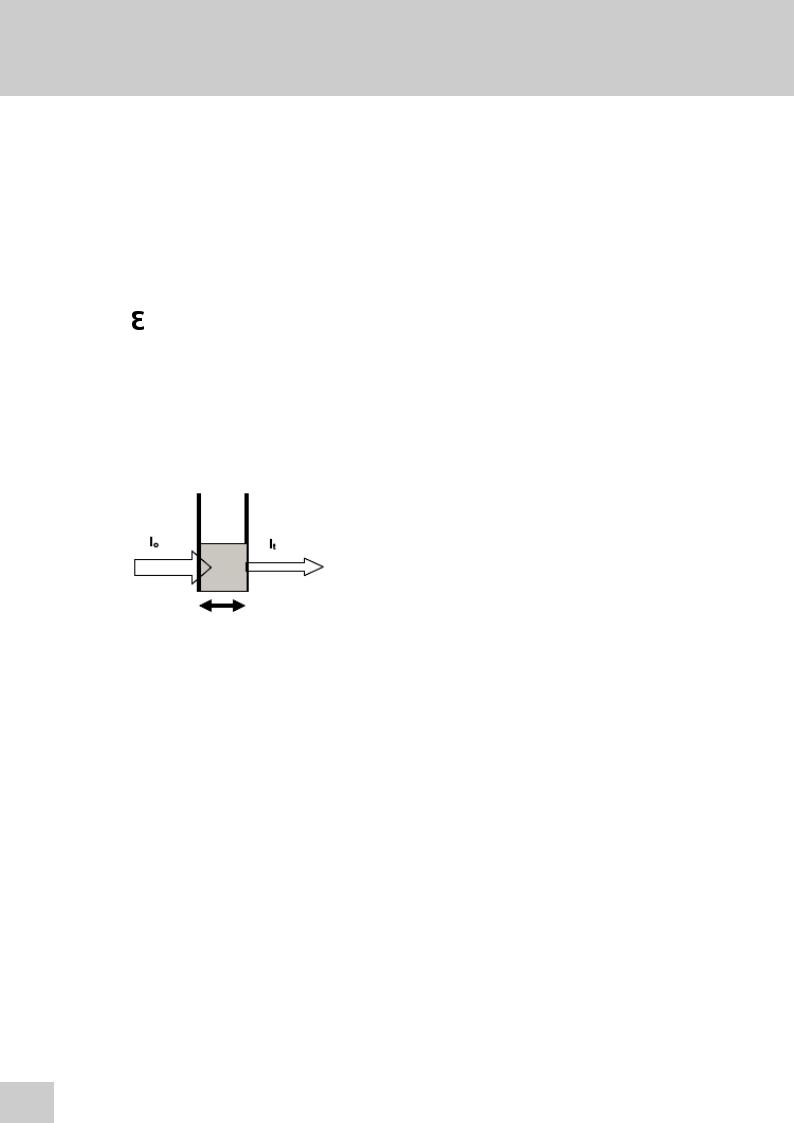
SECTION 3 – Theory and Practice of Spectroscopy Measurements
3.1THEORY OF SPECTROSCOPY MEASUREMENT
UV-visible spectroscopy is the measurement of the absorbance of light at a specific wavelength in a sample. This is used to identify the presence and concentration of molecular entities within the sample. The Beer-Lambert law is used to relate the absorption of light to the properties of the sample through which the light is travelling through. The Beer-Lambert law states that:
A =  l c
l c
A is the absorbance
is the molar absorption coefficient (l mol-1cm-1) c is the concentration (mol l-1)
l is the path length (cm)
This law shows that absorbance is linear to concentration but this is only true for low concentrations. For absorbance levels above 3 the concentration starts to move away from the linear relationship.
Transmittance is the proportion of the light which passes through the sample:
Where:
Lo |
is the incident light |
lt |
is the transmitted light |
l |
is the path length |
l
Therefore:
Absorbance is inversely related to transmittance:
16
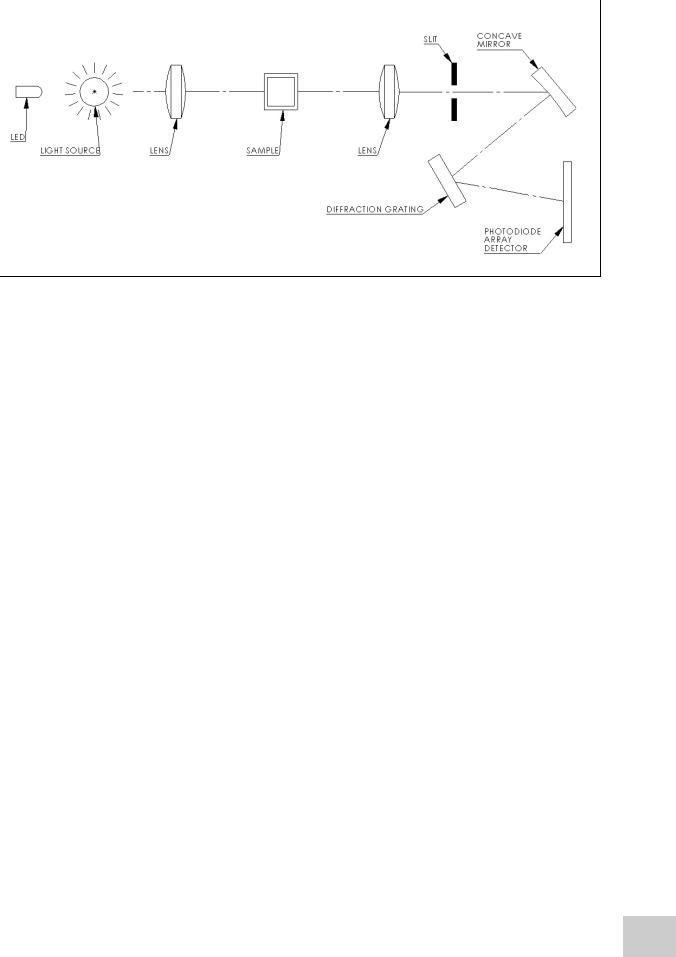
3.2SPECTROSCOPY MEASUREMENT
There are four main components of a spectrophotometer. These are a light source to emit a high and constant amount of energy over the full wavelength range, a sample holder, a method for separating the light into discreet wavelengths and a light detector.
The optical layout of the 7200 spectrophotometer is shown below:
Figure 3.2.1 – Diagram of light path
The whole light spectrum from the pre-aligned tungsten halogen lamp and the LED is collimated through a lens and passed through the sample. The spectrum of light then passes through a further slit and lens arrangement before being focussed onto the diffraction grating, which separates the light into discrete wavelengths. The light which has not been absorbed by the sample is measured by the photodiode array detector. The photo-diode array detector used is mounted directly onto the detector PCB and the output is used to calculate the % transmittance. The result is displayed either as % transmittance or absorbance on the instrument display.
3.3GOOD PRACTICE GUIDELINES
1.For optimum performance all spectrophotometers should be sited in a clean, dry, dust free atmosphere. When in use ambient temperature and light levels should remain as constant as possible.
2.If required adherence to Standard Operating Procedures (SOP) and Good Laboratory Practice (GLP) should be monitored with regular calibration checks and a suitable Quality Control (QC) programme.
3.Ensure that there is nothing additional in the sample chamber which could block the light path during calibration and sample measurement. Do not divert the light path using a mirrored surface within the sample compartment.
4.The correct selection of sample containers is imperative for accurate and reproducible results:
a)Check that the material of the sample container is compatible with the wavelengths to be used for measurement. In general glass can only be used down to 360nm or 320nm depending on quality. Standard plastic cuvettes can be used down to 320nm. Special UV versions can be used down to 260nm. Below this level quartz cuvettes must be used.
b)Plastic disposable cuvettes should only be used ONCE.
17

c)Glass cuvettes should be thoroughly cleaned after use. Discard when scratches become evident on optical surfaces.
d)Care should be taken when selecting semi-micro or micro cuvettes. The cuvette window on the inner chamber (the area filled with sample) must be wider than the aperture in the sample holder or light will reach the detector without passing through the sample. In this case, semimicro or micro cuvettes with self-screening black surrounds must be used or, alternative holders for these cuvettes should be used.
e)Glass test tubes and other sample tubes should be used with care. Where possible, matched tubes should be used and any index mark set to the correct position before measurements are made.
f)Ensure any sample containers used are compatible with the constituents of both the samples and standards they are to hold. Plastic cuvettes are not compatible with organic solvents.
g)All sample containers must be handled with care; by the top, bottom and non-optical surfaces only. Any finger marks evident must be removed by a suitable cleaning process.
h)Flow-through cuvettes must be selected with care and consideration for the sample type, sample volume, pumping system, rinse, sample and waste handling to be used.
5.Samples and standards should not be stored in open cuvettes or sample containers as evaporation will change the value and lead to staining of the walls which may be irreversible.
If stored in stoppered and sealed cuvettes, they should be filled with little or no air space and the values regularly checked against a reference standard or quality control material.
6.Samples should be allowed to equilibrate to ambient temperature before measurement (unless a suitable temperature controlled sample holder is in use). Temperature change during
measurement may cause air bubbles to form on the walls of the sample holder. This is a common cause of drift during measurement.
7.In the preparation of samples and standards high grade borosilicate glass and AR grade chemicals and reagents must be used. Good quality deionised water or other suitable solvents must be used for dissolving or diluting samples, chemicals and reagents.
8.All measurements require calibration to a blank, for maximum accuracy this should be prepared with care using the same deionised water or solvent used for dissolving or diluting the sample. Where reagents are added to the sample to produce a colour proportional to its concentration a ‘sample based’ blank should be used. In this case the blank should consist of all reagents or chemicals to be used, except the sample which will produce the colour to be measured.
9.Deviations from the Beer-Lambert Law may occur at high and low concentrations giving non-linear response during sample concentration measurements. For all new methods a linear range should be defined by the preparation of a calibration curve. The quantitation mode may be used to construct such a curve against which sample results are automatically measured.
10.Cuvettes and sample holders must be filled to a minimum level which covers the light path. All Jenway spectrophotometers have a beam height of 15mm.
11.The instrument must be calibrated to zero absorbance/100% transmittance prior to taking readings. In the spectrum measurement mode a baseline scan must be performed before performing a sample scan.
18
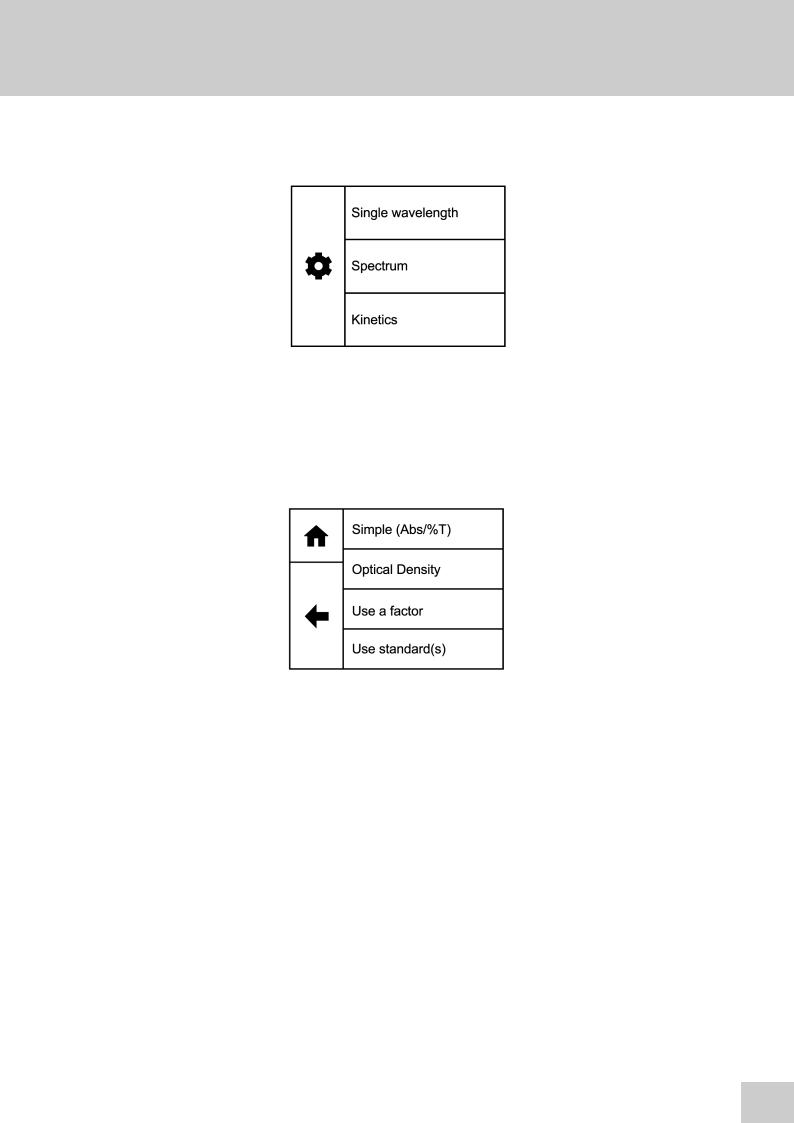
SECTION 4 – Instrument Setup
4.1NAVIGATING AND SCREEN SETUP
The main home screen is displayed below:
Model 7200 has a colour touchscreen user interface. To navigate around the spectrophotometer screen, touch the icon or text which you want to action.
In every screen there is a back arrow which returns to the previous screen without saving any changes.
In each measurement mode there is a home icon which returns immediately to the home screen.
4.2INSTRUMENT SETTINGS SCREEN
The instrument settings screen is accessed by touching the instrument settings icon in the Home Screen. This screen enables access to printing and saving options, heated cell accessory control, setting date and time, language and software updates. Touch the down arrow to view the second screen.
19
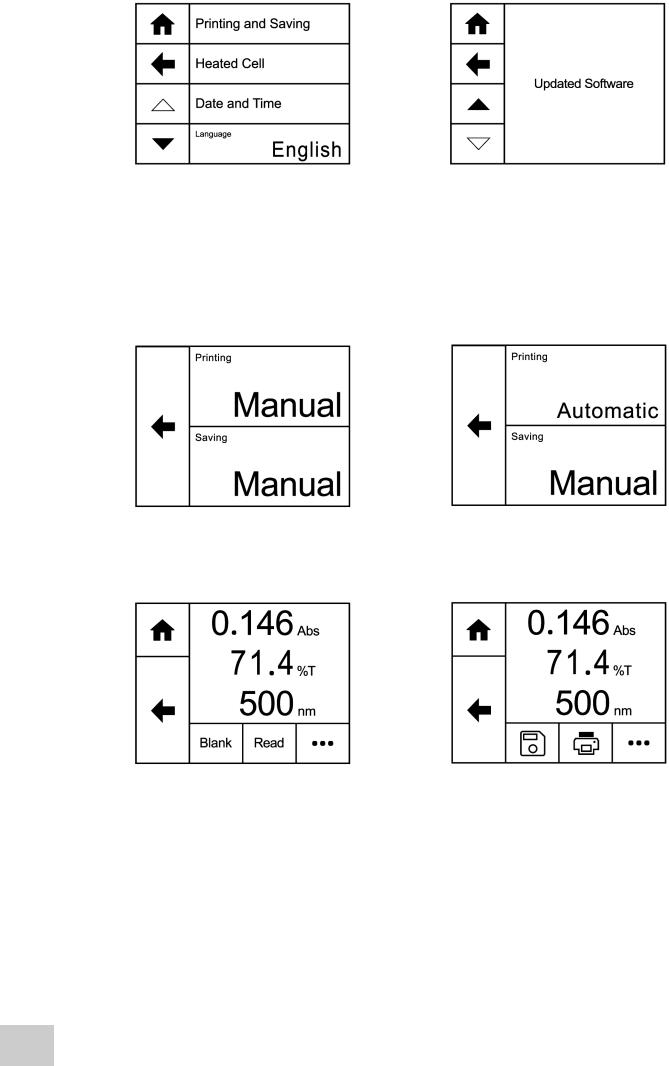
4.3PRINTING AND SAVING
Printing (with the accessory printer) and saving (to a USB memory stick) can be performed manually in each mode but for selected measurement modes it can also be set up be carried out automatically. Automatic saving can only be done in the single measurement modes.
Touch Printing or Saving to toggle between Manual and Automatic.
To print or save manually in any measurement mode, touch the overflow icon button at the bottom of the screen.
Touching the overflow icon displays the options for manual printing or manual saving. Touch the save icon to save the result to USB memeory stick. If a USB memory stick is not inserted an error message will be displayed. Touch the print icon to print the results using an external printer. If the printer is not connected, switched on or out of paper an error message will be displayed. Touching the overflow icon
20

icon once again will cycle the screen back to the previous view, allowing blank and sample measurements to be performed.
Once a sample reading has been performed if the results are not saved to USB memory stick a warning message will be displayed when the mode is exited by pressing the Home icon.

Touch Continue to exit the measurement mode and the results will not be saved. Touch Return to return to the measurement mode so that the results can be saved.
4.4HEATED CELL ACCESSORY CONTROL
A heated 10x10mm cuvette holder is available as an optional accessory for Model 7200. This accessory enables the temperature of the sample to be adjusted. To set up the parameters of the heated cell accessory, touch Heated Cell in the Settings screen. Touch Use Heated Cell to toggle between Off and On.
To adjust the temperature of the heated cell, touch Heated Cell Temperature. Touch the up or down arrows to increase or decrease the set temperature in 0.5°C increments. The minimum temperature is 32°C, the maximum temperature is 42°C. Touch OK to confirm or touch the back arrow to return to the previous screen without saving any changes. Please note that the heated cell takes approximately 30 mins to heat a 2.5ml sample to 37°C.
21
